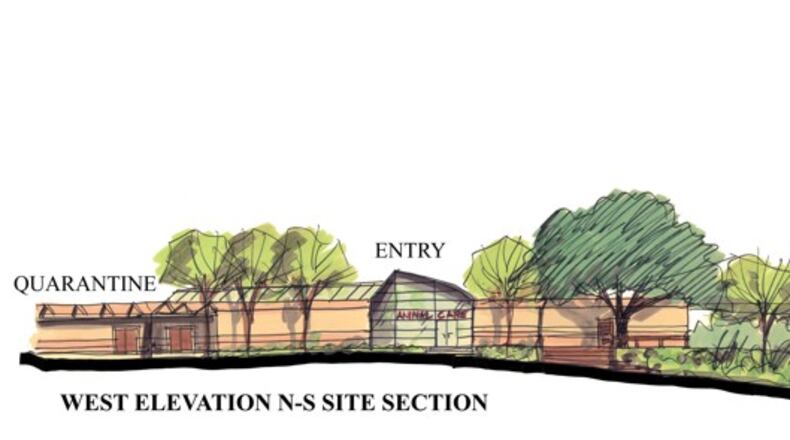Zoo Atlanta ceremonially breaks ground on a new animal health center today, a facility that will dramatically upgrade the zoo’s ability to diagnose and treat its collection of 1,300 birds, reptiles and mammals.
The Rollins Animal Health Center will be ten times the size of the old veterinary facility — 16,000 square feet instead of 1,600 square feet — and will incorporate significant improvements in animal care.
Credit: Zoo Atlanta
Credit: Zoo Atlanta
Chief among these is the inclusion of a computer tomography room which will, for the first time, allow the zoo to get more detailed scans of their animal patients without leaving the property.
The new structure will also allow the zoo to accommodate their 15-person staff all in one building.
Credit: Zoo Atlanta
Credit: Zoo Atlanta
Currently the staff bounces between three different buildings, with treatment facilities in what was originally a city of Atlanta lawnmower shed, the Silberman Clinic for treating great apes, and a separate kitchen/nutrition center.
The zoo began planning for this construction in 2007 but several factors delayed the project, including the financial crisis of 2007-2008 and, later, the pandemic. It’s been in the works for almost all of the 18 years that Dr. Sam Rivera, senior director of animal health, has served the zoo, and his anticipation has built up during the long delay, to the point where he has memorized the designs.
“I’ve dreamed about these floor plans, I’ve thought about them, I’ve looked at them so long, I can close my eyes and walk through the layout of the building,” said Rivera.
Credit: Zoo Atlanta
Credit: Zoo Atlanta
The addition of an in-house CT imaging department will have an immediate positive effect on the zoo’s ability to diagnose disease, Rivera said.
Until now the zoo’s veterinarians have been forced to rely on local veterinary hospitals and the University of Georgia veterinary department, 90 minutes away in Athens, when they needed to generate scans of sick animals.
Making those trips was problematic for the animals, which had to be put under anesthesia for a longer time, and were stressed by the travel time.
The Rollins Center will also have enhanced laboratory space. Many of the tests on specimens taken from animals are currently conducted by other labs. The in-house lab space will speed that process.
Rivera said the new building will also have improved teaching facilities, and will even have two apartments where interns and visiting scientists can stay overnight. “There are times when we need to have experts come spend several weeks with us” said Rivera. The new facility will accommodate that need.
Designed by Torre Design Consortium Ltd., the $22 million center will be built by Turner Construction Company and FS360, with a goal of creating a silver or gold LEED-certified building. (LEED certification establishes that the building is energy efficient and sustainable in design, construction and operation.) It should be completed in 14 months and will be ready by late summer or early fall of 2024, said Rivera.
Plans for the new facility were put on hold during the recession, and later the zoo focused its efforts on creating a new reptile house to replace the zoo’s oldest facility, breaking ground for the Scaly Slimy Spectacular in 2013.
In the midst of that project, the city of Atlanta, the zoo and the Atlanta History Center decided to move the monumental historical painting, the Cyclorama, from Grant Park to the history center in Buckhead. That move freed up the historic Cyclorama building and five additional acres for the zoo to grow.
“This was a once-in-a-lifetime opportunity for the zoo to expand,” said Raymond B. King, president and CEO. “That took on a life of its own. It was a big project.”
An extensive renovation transformed the old Cyclorama building into Savanna Hall, an events facility (that opened in 2020) which was at the center of the African Savanna, a new elephant habitat, which opened in 2019.
Then came the pandemic. Finally, the zoo is ready to put shovels in the ground for a new animal hospital. The architects, Torre Design, have specialized in drawing designs for zoological parks, and created the plans for Scaly Slimy.
During fundraising for the project, which began late last year, the Gary W. Rollins Foundation, a long-time supporter of the zoo, offered a lead donation of $3 million.
Over the last ten years more than a third of the zoo has been renovated, and there is another project on the back burner said King.
“It feels great to be getting to this point, said King. “It’s the next step in our ongoing transformation.”
Fast facts about the Rollins Animal Health Center:
- Features will include laboratory, pharmacy, radiology, treatment, and surgical spaces, a CT scanning room and a necropsy suite.
- There are interior and exterior animal holding dens for animals undergoing treatment. Five quarantine dens will be available for newly arrived animals.
- In addition to office and conference space, the second floor will feature two dorm rooms, restrooms and laboratory facilities for veterinary team members who need to stay overnight and for hosting visiting colleagues or students.
- Food preparation for all the zoo’s animals is under the guidance of the veterinary staff, and will take place in the Rollins Center.
- The zoo’s animal care team includes nine veterinarians, four vet technicians and a quarantine keeper.
About the Author
The Latest
Featured






